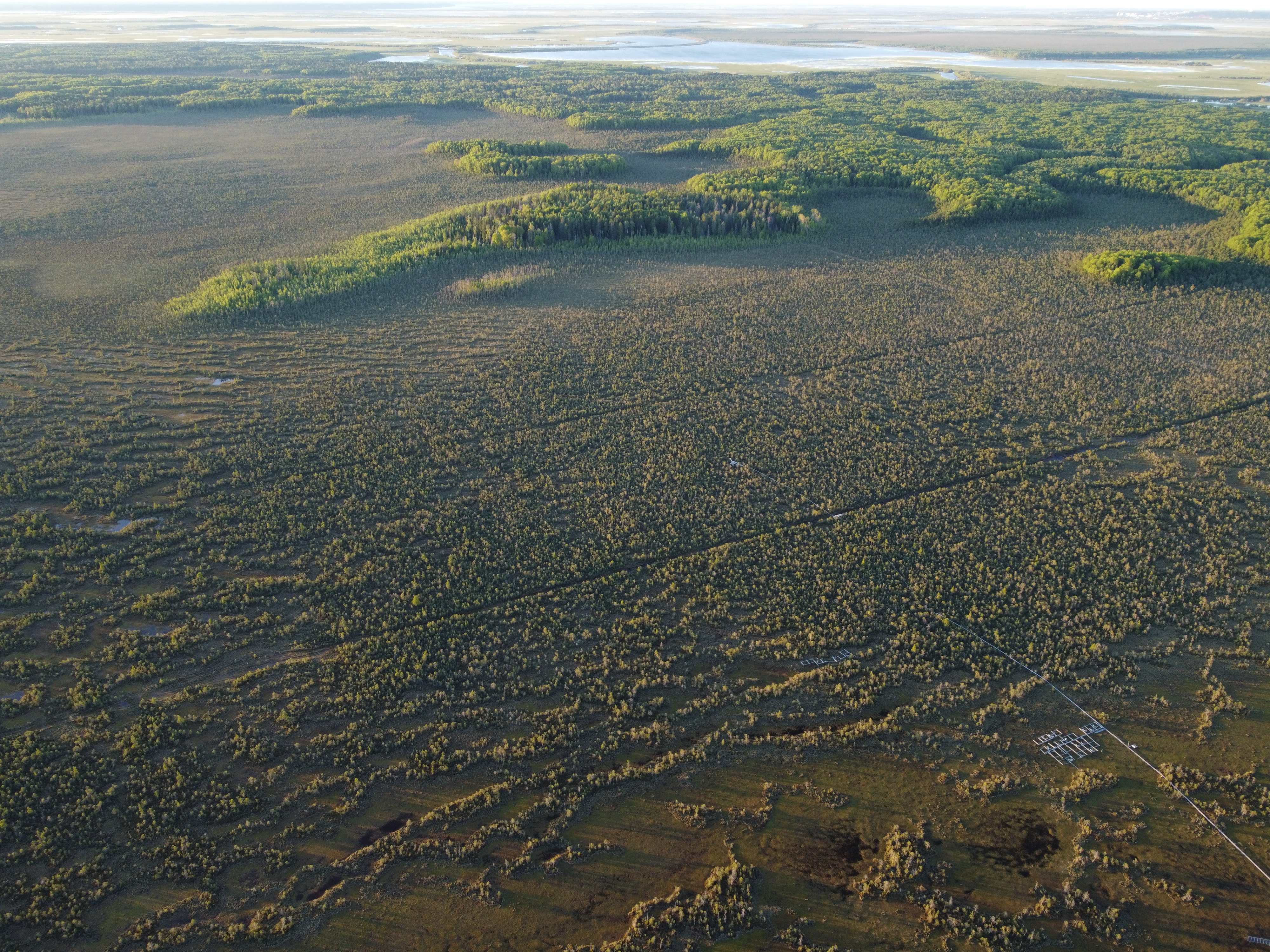Chamber measurements of carbon dioxide fluxes
Automated monitoring of carbon dioxide fluxes at ridge-hollow patterned bog performed since 2017 using a portable atmospheric soil measuring system (ASMS) with two transparent chambers. Automated chambers were installed at a pine-dwarf shrubs-Sphagnum ridge and Sphagnum hollow. The ASMS is able to measure and record simultaneously the following environmental characteristics:
- air temperature (Ta) and humidity (RH) (at height of 2 m above the ground and at the ground surface),
- PAR (photosynthetic active radiation; incoming solar radiation in the 400-700 nm spectral range),
- air carbon dioxide concentration and water vapor pressure.
The system includes a two-channel gas analyzer Li-7000 (Li-COR Biogeosciences, USA) and two measuring chambers with a volume of 120 l. The chambers are closed for 5 minutes every hour (or 3 hours in 2017) to provide a flux measurement. The rest of the time they remain open. The air for a sample is continuously pumped through the chamber and the gas analyzer during the observation period using a diaphragm pump 7006ZVR (Gardner Denver Thomas GmbH, Germany) with a flow rate ~2 l/minute. The measurements of the concentration of CO2 and H2O, Ta, RH and PAR are continuously stored in the ASMS and transferred to a web-server.





Eddy covariance measurements
An eddy covariance (EC) tower was deployed in a representative part of the Mukhrino bog at ridge-hollow patterned bogs in 2015 in order to provide continuous, ecosystem-scale data on GHG exchange and energy balance (N60.89139, E68.67624). At time of establishment, it was the first permanent EC setup within a radius of ca. 1000 km and only in Western Siberia. The EC instrumentation consisted of:
- a CO2 H2O analyzer LI-7500,
- 3-D ultrasonic anemometer (Gill R3, Gill Instruments Limited, UK).
During the first season, the measurements were made from May to August 2015 and provided appropriate flux data coverage for the entire growing season. Raw EC data were processed using the EddyUH software. An energy balance closure of 0.99 was observed, pointing at good quality of the EC data. The 4 m a.g.l. EC sensor mounting height resulted in a 70% footprint zone with a radius of ca. 89-202 m depending on atmospheric stability, covering a representative mix of ridge and hollow microsites.
The EC system at ridge-hollow patterned bogs was updated in 2021. New 7m tower was equipped with:
- enclosed path CO2 H2O gas analyser Li-7200,
- open path CH4 gas analyser Li-7700
- 3D ultrasonic anemometer Metek Cage uSonic-3 MP.




New EC system was established at treed pine-shrab-sphagmnum bog (N60.89651, E68.68178) with 10 mast and equipped with:
- enclosed path CO2 H2O gas analyser Li-7200,
- 3D ultrasonic anemometer Metek Cage uSonic-3 MP.



Mukhrino EC tower included in the EC network managed by the Max-Planck-Institute for Biogeochemistry (Mathias Göckede) in collaboration with the Arctic Data Center hosted by NCEAS at UC Santa Barbara: http://cosima.nceas.ucsb.edu/carbon-flux-sites/
Publications
Dyukarev E., Zarov E., Alekseychik P., Nijp J., Filippova N., Mammarella I., Filippov I., Bleuten W., Khoroshavin V., Ganasevich G., Meshcheryakova A., Vesala T., Lapshina E. The multiscale monitoring of peatland ecosystem carbon cycling in the middle taiga zone of Western Siberia: the Mukhrino bog case study // Land 2021, 10(8), 824; https://doi.org/10.3390/land10080824.
Alekseychik, P., Mammarella, I., Karpov, D., Dengel, S., Terentieva, I., Sabrekov, A., Glagolev, M., Lapshina, E., 2017. Net ecosystem exchange and energy fluxes measured with the eddy covariance technique in a western Siberian bog. Atmos. Chem. Phys. 17, 9333–9345. https://doi.org/10.5194/acp-17-9333-2017
Alekseychik, P., Lappalainen, H., Petäjä, T., Zaitseva, N., Heimann, M., Laurila, T., Lihavainen, H., Eija, E., Arshinov, M., Shevchenko, V., Makshtas, A., Dubtsov, S., Mikhailov, E., Lapshina, E., Kirpotin, S., Kurbatova, Y., Ding, A., Guo, H., Park, S., Lavric, J., Reum, F., Panov, A., Prokushkin, A., Kulmala, M., 2016. Ground station network in the Boreal-Arctic Pan-Eurasian region: an overview [Cеть наземных станций в Бореально-Арктическом Пан-Евразийском регионе: обзор]. Geography, environment, sustainability 9, 75–88. https://doi.org/10.15356/2071-9388_02v09_2016_06
Lapshina, E.D., Alekseyshik, P., Dengel, S., Filippova, N.V., Zarov, E.A., Filippov, I.V., Terentyeva, I.E., Sabrekov, A.F., Solomin, Y.R., Karpov, D.V., Mammarella, I., 2015. A new peatland research station in the center of West Siberia: description of infrastructure and research activities. Proceedings of the 1st Pan – Eurasian Experiment (PEEX) Conference and the 5th PEEX Meeting. Report series in aerosol science. 163, 236–240. (Pdf)
Last update 10/07/2022
